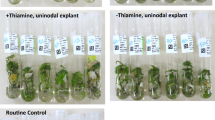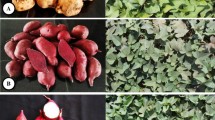Abstract
Sweetpotato (Ipomoea batatas L.) is an important crop in North Carolina with annual production of 0.33 million tons, accounting for 37% of total US supply (USDA, Louisiana Farm Reporter 8(12), August 2008). To target industrial use, novel high-starch industrial-type varieties that contain more than 30% dry matter were developed by conventional breeding methods. In vitro cultures from selected genotypes were established using meristem culture. To establish regeneration procedures that could be coupled with transformation experiments, conditions for the induction of rapid shoot-organogenesis in leaf explants were compared using varying concentrations of the auxins ‘NAA’, ‘IAA’, ‘2,4-D’, and ‘4-FA’ either alone or in combination with zeatin riboside. Regeneration efficiencies, defined as the number of explants developing shoots out of the total number tested, were as high as 57% for the best genotypes, with a significant genotype-dependent response observed in all the hormone regimes evaluated. In all treatments, shoot regeneration was observed within 2 months. Our results led to the establishment of optimized in vitro regeneration procedures for the novel high-starch sweetpotato (SP) genotypes ‘DM01-158’, ‘FTA94’, ‘FT489’, and ‘PDM P4’ that are rapid and reliable.



Similar content being viewed by others
Abbreviations
- BAP:
-
6-Benzylaminopurine
- IAA:
-
Indole-3-acetic acid
- NAA:
-
Naphthaleneacetic acid
- SP:
-
Sweetpotato
- 2,4-D:
-
2,4-Dichlorophonoxyacetic acid
- 4-FA:
-
4-Fluorophenoxyacetic acid
References
Al-Mazrooei S, Bhatti MH, Henshaw GG et al (1997) Optimization of somatic embryogenesis in fourteen cultivars of sweet potato (Ipomoea batatas (L.) Lam.). Plant Cell Rep 16(10):710–714. doi:10.1007/s002990050307
Cavalcante AJM, Sihachakr D, Allot M et al (1994) Isozyme modifications and plant regeneration through somatic embryogenesis in sweet potato (Ipomoea batatas (L.) Lam.). Plant Cell Rep 13(8):437–441
Chen L, Bhagsari A, Carter J (2006) Effects of medium composition and culture duration on in vitro morphogenesis of sweet potato. Biol Plant 50(1):114–117. doi:10.1007/s10535-005-0083-9
Cheng HH, Yeh MS (2003) Studies on tissue culture of sweet potato. I. The effects of different kinds and concentration of auxin on plant regeneration of explants from different parts. J Agric For 52(3):63–79
Cheng HH, Yeh MS (2004) In vitro culture of sweet potato. III. Histological studies on root and shoot regeneration from leaf cultures of Ipomoea batatas (L.) Lam. Crop Environ Bioinformatics 1(2):102–111
Cipriani G, Michaud D, Brunelle F et al (1999) Expression of soybean proteinase inhibitor in sweetpotato. Impact on a Changing World. International Potato Center Program Report 1997–1998:271–277
Dessai AP, Gosukonda RM, Blay E et al (1995) Plant regeneration of sweetpotato (Ipomoea batatas L.) from leaf explants in vitro using a two-stage protocol. Sci Hortic (Amsterdam) 62(4):217–224. doi:10.1016/0304-4238(95)00767-N
FAOSTAT (2008) Production/ProdSTAT/Crops. http://faostat.fao.org/site/526/default.aspx. Cited September 2008
Gama MICS, Leitre RPJ, Cordeiro AR et al (1996) Transgenic sweet potato plants obtained by Agrobacterium tumefaciens-mediated transformation. Plant Cell Tissue Organ Cult 46(3):237. doi:10.1007/BF02307100
Garcia M, Somontes D, Mena J et al (1999) Plant regeneration from leaf and stem explants from two sweet potato (Ipomoea batatas L.) Lam. cultivars. Biotecnol Apl 16(1):11–14
Garcia R, Moran R, Mena J et al (2000) Sweet potato (Ipomoea batatas L.) regeneration and transformation technology to provide weevil (Cylas formicarius) resistance. Field trial results. In: Proceedings of the international symposium on plant genetic engineering. Havana, Cuba, December 1999, pp 112–117
Gong Y, Gao F, Tang K (2005) In vitro high frequency direct root and shoot regeneration in sweet potato using the ethylene inhibitor silver nitrate. S Afr J Bot 71(1):110–113
Gosukonda RM, Prakash CS, Dessai AP (1995) Shoot regeneration in vitro from diverse genotypes of sweetpotato and multiple shoot production per explant. HortScience 30(5):1074
James AC, Peraza-Echeverria S, Peraza-Echeverria L et al (2007) Variation in micropropagated plants. Acta Hortic 748:55–63
Kuo CG (1991) Conservation and distribution of sweet potato germplasm. In vitro methods for conservation of plant genetic resources. Chapman and Hall, London
Kuo CG, Shen BJ, Shen MJ et al (1985) Virus-free sweet potato storage roots derived from meristem-tips and leaf-cuttings. Sci Hortic (Amsterdam) 26(3):231–240. doi:10.1016/0304-4238(85)90110-4
Liu JR, Cantliffe DJ (1984) Somatic embryogenesis and plant regeneration in tissue cultures of sweet potato (Ipomoea batatas Poir.). Plant Cell Rep 3(3):112–115. doi:10.1007/BF02441013
Liu QC, Zhai H, Wang Y et al (2001) Efficient plant regeneration from embryogenic suspension cultures of sweetpotato. In Vitro Cell Dev Biol Plant 37(5):564–567. doi:10.1007/s11627-001-0098-7
Love SL, Rhodes BB (1985) Improved methods for meristem culture of sweet potatoes. HortScience 20(4):655
Luo HR, Santa-Maria M, Benavides J et al (2006) Rapid genetic transformation of sweetpotato (Ipomoea batatas (L.) Lam.) via organogenesis. Afr J Biotechnol 5(20):1851–1857
Morán R, García R, López A et al (1999) Transgenic sweet potato plants carrying the delta-endotoxin gene from Bacillus thuringiensis var. tenebrionis. Plant Sci (Limerick) 139(2):175–184
Otani M, Shimada T (1996) Efficient embryogenic callus formation in sweet potato (Ipomoea batatas (L.) Lam.). Breed Sci 46(3):257–260, 287
Otani M, Wakita Y, Shimada T (2001) Genetic transformation of sweet potato (Ipomoea batatas (L.) Lam.) by Agrobacterium tumefaciens. Acta Hortic 560:193–196
Padmanabhan K, Cantliffe DJ, Harrell RC et al (1998) Computer vision analysis of somatic embryos of sweet potato (Ipomoea batatas (L.) Lam.) for assessing their ability to convert to plants. Plant Cell Rep 17(9):681–684. doi:10.1007/s002990050465
Pido N, Kowyama Y, Shimonish K et al (1995) Plant regeneration from adventitious root segments derived from leaf discs. Plant Tissue Cult Biotechnol 1(2):81–84
Santa-Maria M (2003) Evaluation of a new selectable marker for the Agrobacterium tumefaciens mediated transformation in sweet potato (Ipomoea batatas (L.) Lam.). Thesis, La Molina National Agrarian University
Shang YF, Yang CL, Xin XQ et al (1996) Technique for virus-free sweet potato production by meristem tip culture. Plant Prot 22(5):14–16
Shin SI, Kim HJ, Ha HJ et al (2005) Effect of hydrothermal treatment on formation and structural characteristics of slowly digestible non-pasted granular sweet potato starch. Starch/Starke 57(9):421–430
Sihachakr D, Haicour R, Cavalcante Alves JM et al (1997) Plant regeneration in sweet potato (Ipomoea batatas L., Convolvulaceae). Euphytica 96(1):143–152. doi:10.1023/A:1002997319342
Song GQ, Honda H, Yamaguchi K (2004) Efficient Agrobacterium tumefaciens-mediated transformation of sweet potato (Ipomoea batatas (L.) Lam.) from stem explants using a two-step kanamycin-hygromycin selection method. In Vitro Cell Dev Biol Plant 40(4):359–365. doi:10.1079/IVP2004539
Thinh NT, Santangelo E, Sonnino A (1997) Effect of genotype, explant size and medium composition on somatic embryogenesis and plant regeneration in sweetpotato (Ipomoea batatas (L.) Lam.). J Genet Breed 51(1):63–67
Tsao CWV, Postman JD, Reed BM (2000) Virus infections reduce in vitro multiplication of ‘Malling Landmark’ raspberry. In Vitro Cell Dev Biol Plant 36(1):65–68. doi:10.1007/s11627-000-0015-5
USDA (2008) Sweet potatoes. Louisiana Farm Reporter 8(12), August 2008
Wilson PW, Labonte DR, McCure GB et al (2007) Enzymatic conversion and fermentation of sweetpotato. HortScience 42(3):459
Woolfe JA (1992) Sweet potato: an untapped food resource. Cambridge University Press, Cambridge, England
Zheng Q, Dessai AP, Prakash CS (1996) Rapid and repetitive plant regeneration in sweetpotato via somatic embryogenesis. Plant Cell Rep 15(6):381–385. doi:10.1007/BF00232059
Acknowledgements
This work was funded by Bayer CropScience Corporation, the Golden LEAF Foundation, and The Consortium for Plant Biotechnology Research. Special thanks to the ‘Micropropagation Unit’ and the ‘Plant Transformation Laboratory’ at North Carolina State University (NCSU) for providing infrastructure, materials, and helpful discussions.
Author information
Authors and Affiliations
Corresponding author
Rights and permissions
About this article
Cite this article
Santa-Maria, M., Pecota, K.V., Yencho, C.G. et al. Rapid shoot regeneration in industrial ‘high starch’ sweetpotato (Ipomoea batatas L.) genotypes. Plant Cell Tiss Organ Cult 97, 109–117 (2009). https://doi.org/10.1007/s11240-009-9504-3
Received:
Accepted:
Published:
Issue Date:
DOI: https://doi.org/10.1007/s11240-009-9504-3




